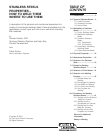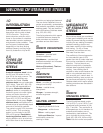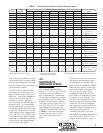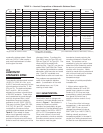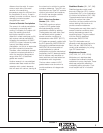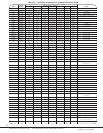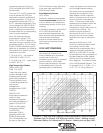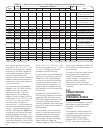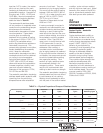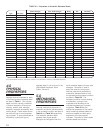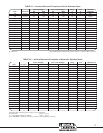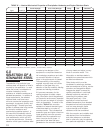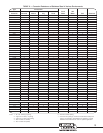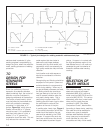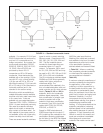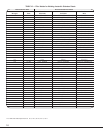
9
less than 0.07% carbon, the marten-
site is not very hard and the main
hardening is obtained from the aging
(precipitation) reaction. Examples of
this group are 17-4PH, 15-5PH and
PH13-8Mo. Nominal compositions
of precipitation hardening stainless
steels are listed in Table IV.
The semiaustenitic stainless steels
will not transform to martensite when
cooled from the austenitizing temper-
ature because the martensite
transformation temperature is below
room temperature. These steels
must be given a conditioning
treatment which consists of heating
in the range of 1350 to 1750°F (732
to 954°C) to precipitate carbon
and/or alloy elements as carbides or
intermetallic compounds. This
removes alloy elements from solution,
thereby destabilizing the austenite,
which raises the martensite
transformation temperature so that a
martensite structure will be obtained
on cooling to room temperature.
Aging the steel between 850 and
1100°F (454 to 593°C) will stress
relieve and temper the martensite to
increase toughness, ductility, hard-
ness and corrosion resistance.
Examples of this group are 17-7PH,
PH 15-7 Mo and AM 350.
The austenitic precipitation hardening
stainless steels remain austenitic after
quenching from the solutioning
temperature even after substantial
amounts of cold work. They are
hardened only by the aging reaction.
This would include solution treating
between 1800 and 2050°F (982 to
1121°C), oil or water quenching and
aging at 1300 to 1350°F (704 to
732°C) for up to 24 hours.
Examples of these steels include
A286 and 17-10P.
If maximum strength is required in
martensitic and semiaustenitic pre-
cipitation hardening stainless steels,
matching or nearly matching filler
metal should be used and the com-
ponent, before welding, should be in
the annealed or solution annealed
condition. Often, Type 630 filler
metal, which is nearly identical with
17-4PH base metal, is used for
martensitic and semiaustenitic PH
stainlesses. After welding, a
complete solution heat treatment
plus an aging treatment is preferred.
If the post weld solution treatment is
not feasible, the components should
be solution treated before welding
then aged after welding. Thick
sections of highly restrained parts
are sometimes welded in the
overaged condition. These would
require a full heat treatment after
welding to attain maximum strength.
The austenitic precipitation hardening
stainless steels are the most difficult
to weld because of hot cracking.
Welding should preferably be done
with the parts in the solution treated
condition, under minimum restraint
and with minimum heat input. Nickel
base alloy filler metals of the NiCrFe
type or conventional austenitic stain-
less steel type are often preferred.
3.5
DUPLEX
STAINLESS STEELS
Duplex Ferritic – Austenitic
Stainless Steels
Duplex stainless steels solidify as
100% ferrite, but about half of the
ferrite transforms to austenite during
cooling through temperatures above
approx. 1900°F (1040°C). This
behavior is accomplished by
increasing Cr and decreasing Ni as
compared to austenitic grades.
Nitrogen is deliberately added to
speed up the rate of austenite
formation during cooling. Duplex
stainless steels are ferromagnetic.
They combine higher strength than
austenitic stainless steels with
fabrication properties similar to
austenitics, and with resistance to
chloride stress corrosion cracking of
ferritic stainless steels. The most
common grade is 2205 (UNS
S32205), consisting of 22%Cr, 5%Ni,
3%Mo and 0.15%N.
Austenitic Ferritic Martensitic Precipitation
Property Types Types Types Hardening Types
Elastic Modulus; 10
6
psi 28.3 29.0 29.0 29.0
GPa 195 200 200 200
Density; lb./in.
3
0.29 0.28 0.28 0.28
g/cm
3
8.0 7.8 7.8 7.8
Coeff. of Therm. Expansion: µin./in. °F 9.2 5.8 5.7 6.0
µm/m °C 16.6 10.4 10.3 10.8
Thermal. Conduct.; Btu/hrft. °F 9.1 14.5 14.0 12.9
w/mk 15.7 25.1 24.2 22.3
Specific Heat; Btu/lb. °F 0.12 0.11 0.11 0.11
J/k °K 500 460 460 460
Electrical Resistivity, µΩcm 74 61 61 80
Magnetic Permeability 1.02 600-1,100 700-1000 95
Melting Range °F 2,500-2,650 2,600-2,790 2,600-2,790 2,560-2,625
°C 1,375-1,450 1,425-1,530 1,425-1,530 1,400-1,440
TABLE V — Physical Properties of Groups of Stainless Steels



